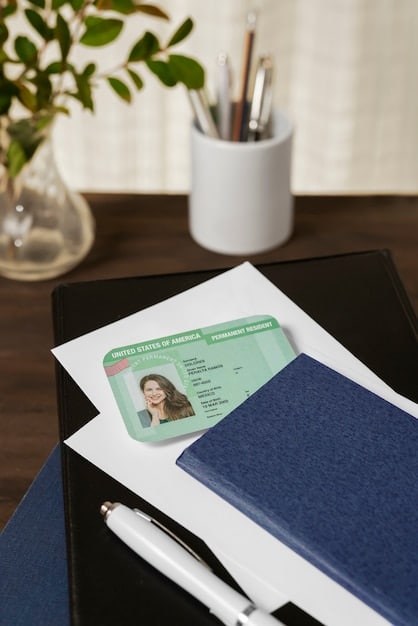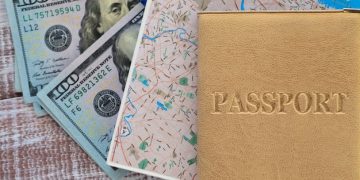Lost or Stolen Passport Abroad? A Step-by-Step Guide for US Citizens

Losing your passport abroad can be a stressful experience for US citizens; however, knowing the immediate steps to take, such as reporting the loss or theft to local police and the nearest US embassy or consulate, and understanding how to apply for a replacement passport, can help you navigate the situation and return home safely.
Losing your passport while traveling abroad can turn your dream vacation into a nightmare. But don’t panic! This guide is designed to help US citizens navigate the process of reporting a lost or stolen passport abroad and obtaining the necessary documentation to return home.
What to Do Immediately After Realizing Your Passport is Lost or Stolen?
Discovering that your passport is missing or has been stolen while you are abroad can be a very unsettling experience. It is important to act quickly and efficiently to mitigate the potential damage and start the process of obtaining replacement documentation. Here’s a detailed guide on the immediate steps you should take.
Report the Loss or Theft to Local Police
Your first action should be to report the loss or theft to the local police. This is a crucial step, as a police report will be required when you apply for a replacement passport. The police report serves as official documentation of the incident, proving that you reported the missing passport. Be as detailed as possible when providing information to the police, including the time and location where you last saw your passport, and any circumstances that might have led to its loss or theft.
Notify the Nearest US Embassy or Consulate
Once you’ve filed a police report, contact the nearest US embassy or consulate. The embassy or consulate is the primary resource for US citizens who need assistance while abroad. They can provide guidance, help you navigate local laws, and most importantly, assist you in obtaining a replacement passport. You can find the contact information for the nearest US embassy or consulate on the State Department’s website. Have your travel itinerary and any identification documents available when you contact them.
- Police Report: Obtain a copy of the police report as proof of reporting the incident.
- Embassy Notification: Contact the nearest US embassy or consulate immediately.
- Documentation Preparation: Gather available identification documents and travel itinerary.
Taking these immediate steps will help protect you from potential identity theft and expedite the process of getting a replacement passport, allowing you to continue your travels with minimal disruption.
Applying for an Emergency Passport
Once you’ve reported your passport as lost or stolen, the next step is to apply for an emergency passport. This document allows you to travel back to the United States. The process involves several key steps and requirements that you should be aware of to ensure a smooth application.
Gather Required Documents
To apply for an emergency passport, you will need to gather several documents. These typically include:
* A completed DS-11 form (Application for a U.S. Passport). You can download this form from the State Department’s website or obtain it at the embassy or consulate.
* Proof of U.S. citizenship, such as a birth certificate, a copy of your lost or stolen passport (if available), or a Certificate of Citizenship.
* A copy of the police report that documents the loss or theft of your passport.
* A valid photo ID, such as a driver’s license.
* Two passport-sized photographs. These photos must meet specific requirements regarding size, background, and facial expression.
* Evidence of your travel plans, such as airline tickets or itineraries.
Schedule an Appointment
After gathering all the necessary documents, the next step is to schedule an appointment at the nearest US embassy or consulate. Appointments are usually required for passport services, so it’s important to plan ahead. You can typically schedule an appointment online through the embassy or consulate’s website. Be sure to specify that you are applying for an emergency passport due to a lost or stolen passport. In some cases, walk-in appointments may be available, but it’s best to confirm this in advance.

Applying for an emergency passport requires careful attention to detail and adherence to the specific requirements of the US embassy or consulate. By gathering the necessary documents, scheduling an appointment, and understanding the interview process, you can navigate this process efficiently and obtain the necessary travel documentation to return home.
Understanding the DS-11 Form
The DS-11 form is a crucial component of the passport application process, especially when applying for a replacement passport after a loss or theft. Familiarizing yourself with this form and knowing how to complete it accurately can significantly expedite your application.
Key Sections of the DS-11 Form
The DS-11 form is divided into several key sections, each requiring specific information about the applicant. Here are the main sections you need to be aware of:
* Personal Information: This section requires your full legal name, date and place of birth, gender, and social security number. Ensure that all information matches your official records.
* Contact Information: Provide your current mailing address, phone number, and email address. This is where the embassy or consulate will send any correspondence regarding your application.
* Travel Plans: Include details about your upcoming travel plans, such as your departure date, destination, and the purpose of your trip.
* Previous Passport Information: If you have previously been issued a passport, provide the issue date and passport number, if known. Even if your passport was lost or stolen, include any information you remember about it.
* Emergency Contact Information: Provide the name, phone number, and email address of someone who can be contacted in case of an emergency.
Tips for Completing the Form Accurately
To ensure that your DS-11 form is processed smoothly, follow these tips:
* Use Black Ink: Fill out the form using black ink to ensure clarity and legibility.
* Answer All Questions: Complete all required fields on the form. If a question does not apply to you, write “N/A” (not applicable).
* Double-Check Information: Review all the information you have provided to ensure it is accurate and consistent with your other documents.
* Do Not Sign the Form: Do not sign the DS-11 form until you are instructed to do so by a consular officer at the embassy or consulate.
Additional Documentation and Proof of Identity
When applying for a replacement passport abroad, providing sufficient proof of identity and U.S. citizenship is essential. This helps the US embassy or consulate verify your identity and ensures that you are eligible to receive a new passport. Here’s what you need to know about gathering and presenting the necessary documents.
Acceptable Forms of Identification
To prove your identity, you should provide as many forms of identification as possible. Acceptable forms of identification typically include:
* A valid driver’s license
* A state-issued identification card
* A copy of your lost or stolen passport (if available)
* Any other government-issued photo ID.
- Birth Certificate: A certified copy of your birth certificate is a primary proof of U.S. citizenship.
- Previous Passport: If available, a copy of your lost or stolen passport can serve as proof of citizenship.
- Certificate of Citizenship: If you are a naturalized citizen, provide your Certificate of Citizenship.

Providing sufficient proof of identity and U.S. citizenship is crucial when applying for a replacement passport abroad. By gathering a comprehensive set of documents, you can help the US embassy or consulate process your application quickly and efficiently, allowing you to continue your travels with minimal disruption.
Navigating the Interview Process
As part of the application process for an emergency passport, you will typically be required to attend an interview at the US embassy or consulate. This interview is an opportunity for a consular officer to verify your identity, assess your circumstances, and ensure that you meet the requirements for a replacement passport.
What to Expect During the Interview
During the interview, a consular officer will ask you questions about your identity, travel plans, and the circumstances surrounding the loss or theft of your passport. Be prepared to provide detailed and honest answers. The officer may ask you to provide additional information or documentation to support your application.
Tips for a Successful Interview
To ensure a smooth and successful interview:
* Arrive on time for your appointment.
* Dress neatly and professionally.
* Be polite and respectful to the consular officer.
* Answer questions honestly and accurately.
* Provide any additional information or documentation requested by the officer.
Navigating the interview process is a crucial step in obtaining an emergency passport abroad. By preparing thoroughly, providing honest and accurate answers, and presenting yourself professionally, you can increase your chances of a successful outcome and expedite the process of getting back on your travel itinerary.
Dealing with Delays and Other Issues
While applying for an emergency passport, you might encounter delays or other issues that could complicate the process. Knowing how to anticipate and handle these challenges can help you navigate the situation more effectively and minimize disruptions to your travel plans.
Common Causes of Delays
Several factors can cause delays in the passport application process, including:
* High demand for passport services at the embassy or consulate.
* Incomplete or missing documentation.
* Difficulties in verifying your identity or citizenship.
* Technical issues or administrative backlogs.
Emergency Contacts and Resources
Traveling abroad can present unexpected challenges, and knowing who to contact in case of an emergency can be invaluable. This section provides essential information on emergency contacts and resources available to US citizens while traveling abroad.
* State Department’s Smart Traveler Enrollment Program (STEP).
Here is a summary table containing key points to guide US citizens who have lost their passports abroad:
| Key Point | Brief Description |
|---|---|
| 🚨 Report Immediately | Report the lost or stolen passport to local police and the nearest US embassy or consulate. |
| 📄 Gather Documents | Collect required documents such as the DS-11 form, proof of citizenship, and a police report. |
| 📅 Schedule Appointment | Schedule an appointment at the US embassy or consulate for passport services. |
| 🤝 Emergency Contacts | Keep a list of emergency contacts, including local authorities, the embassy, and your insurance provider. |
Frequently Asked Questions (FAQ)
First, report the loss or theft to the local police to obtain a police report. Then, contact the nearest US embassy or consulate for assistance and guidance.
You’ll need a completed DS-11 form, proof of US citizenship, a copy of the police report, a valid photo ID, two passport-sized photos, and evidence of your travel plans.
The processing time can vary, but emergency passports are typically issued within 24-48 hours, depending on the embassy or consulate’s workload and the availability of documentation.
Emergency passports are primarily intended for returning to the United States. Check with your destination country’s embassy or consulate for specific entry requirements.
Contact the US embassy or consulate immediately and explain your situation. They may be able to expedite the process or provide temporary travel documents to allow you to travel.
Conclusion
Losing your passport abroad is undoubtedly a stressful event, but by following these steps and staying calm, US citizens can navigate the process effectively. Remember to report the loss immediately, gather the necessary documents, and seek assistance from the nearest US embassy or consulate. Safe travels!





